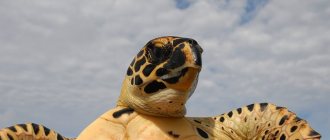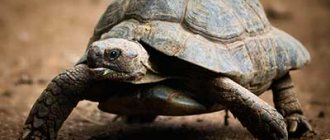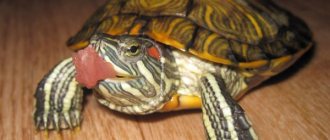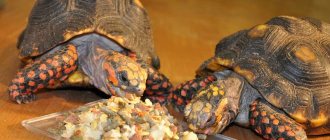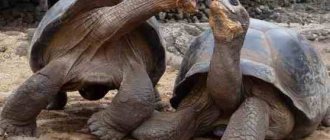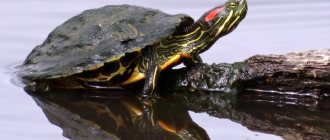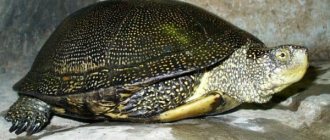Turtles are one of the oldest species of reptiles. These are unique animals that are able to survive in the harshest living conditions. Some species are well adapted to low temperatures, others to high temperatures. Certain subspecies of reptiles can live without food and water for several years, and some can live without oxygen for more than 10 hours. Their size is also striking, which can be a few centimeters or reach 1-2 meters or more.
The ranking shows the largest turtles in the world in terms of size and body weight.
Snapping turtle (35 cm)
Adults discovered by pioneers in the Cayman Islands wear a shell up to 35 cm long. Reptiles weigh up to 14 kg. Found in Canada, Central and Eastern states of America. Favorite habitat is the banks of deep, slow-flowing rivers. Turtles burrow into soft bottom sediments for the winter, raking away the mud with their powerful paws. When it gets cold, the giants fall into deep hibernation.
Large predators easily bite small fish with their beak-shaped jaws. They catch them by throwing their long neck out of their shell with lightning speed. If fishing is unsuccessful, they feed on carrion. A massive head with bulging eyes, three ridge-like saw-like processes on the carapace and a rather long tail are characteristic features of the species.
Red-eared slider (37 cm)
The freshwater red-eared turtle is ranked ninth in the ranking of the largest turtles in the world. Females of this species reach 37 cm in their shell by adulthood. Males are much smaller - up to 20 cm long. Omnivorous reptiles adapt well in captivity. Officially, up to 52 million turtles are sold per year. Individuals can live in apartment aquariums for up to half a century. They are born small, no more than 3 cm. They grow by 5 cm per year.
Turtles are valued for their decorative properties: variegated colors in greenish and olive tones, red spots on the sides of the head. They are inactive - they can not change positions for a long time. In nature, reptiles prefer swampy bodies of water. They can be found on the American continents, Southeast Asia, warm European countries, Africa and Australia. They displace other species of turtles from their habitat.
Fringed turtle (40 cm)
The fringed turtle grows up to 15 kg and is the eighth largest turtle on the planet. The flattened shell grows up to 40 cm in length. These turtles have many distinctive features: a snake-like neck and flat paws overgrown with fringed leathery processes, a flat triangular head, small but keen eyes, small mustaches, a grin from ear to ear, sharp claws.
Matamata, as the people of South America call the turtle, looks like an oblate dragon. She hunts at night. Thanks to its amazing camouflage, the predator is not immediately visible in muddy water. The unwary fish quickly falls into the wide mouth and immediately ends up in the stomach - toothless matamatas. With a lightning-fast throw it can catch a small bird. The reptile prefers shallow river waters with stagnant water. In case of danger, it quickly buries itself in the mud. It spends winter hibernation in it.
Spurred turtle (75 cm)
The seventh place in the top of the largest scoops in the world belongs to the spurred tortoise from Africa. By the age of 20, males gain up to 100 kg of weight, their shell grows up to a meter in length. This species has a good disposition. The turtles are very beautiful, they look like wax sculptures. They take root well in captivity, but large individuals die. Claws and spurs on the hips grow in reptiles by the age of 3. Turtles begin to scratch walls, floors, and end up in zoo terrariums.
In nature, desert inhabitants can go for a long time without water, they feed mainly on plant foods, but they can diversify their menu with protein: insects, carrion. In case of danger, the paws and tail are hidden completely, but the head does not enter the “house”. Land giants are mercilessly exterminated for the sake of beautiful shells, durable skin, and tasty meat.
Arrau (Tartaruga) (1 m)
A giant among freshwater reptiles is the South American river turtle. The egg-shaped shell of large females grows up to a meter long; shield-footed reptiles weigh about 70 kg. Arrau (Tartaruga) live in the Amazon, Orinoco, and Magdalena basins. Blue turtles of the side-necked turtle family spend most of the day in the water. They are peaceful - they feed on plant foods and insects, sometimes diversifying their diet with chicks and small fish.
Reptiles are active all year round and live in large groups. They are exterminated for their tasty meat and valuable eggs - turtle oil is obtained from them, and up to 40 million eggs are processed per year. Turtles do not have hearing organs, so they become easy prey for predators and hunters.
Seychelles giant tortoise (1.2 m)
The Seychelles land tortoise ranks fifth in the ranking of the largest tortoises in the world. It grows up to 120 cm, the weight of such an individual is up to 250 kg. The reptiles were discovered on the Aldabra Atoll in the Indian Ocean; to preserve the species, they were resettled throughout the archipelago and brought to Mauritius, Reunion, and other islands. In captivity, giants can live up to 150 years, in nature no more than 100.
He eats up to 25 kg of food per day, and there are more than 20 plants on the menu. In search of leaves, they raise their hind legs, create pyramids - climb on top of each other. For habitat, the reptile chooses open grassy areas overgrown with sparse shrubs. They are comfortable near mangrove swamps.
Tourists love to feed the peace-loving and curious giants with fruits and take pictures next to them.
Story
As of February 2022, giant tortoises are found on two remote tropical island groups: Aldabra Atoll and Frigate Island in the Seychelles and the Galapagos Islands in Ecuador. These turtles can weigh up to 417 kg (919 lb) and grow up to 1.3 m (4 ft 3 in) in length. Giant tortoises initially entered the islands from the mainland through oceanic dispersal. Turtles are aided in this dispersal by their ability to swim with their heads up and survive for up to six months without food or fresh water. Giant tortoises were once placed in one genus (often called Testudo
or
Geochelone
), but more recent research has shown that giant tortoises represent several different lineages that are not closely related to each other.
These lineages appear to have independently evolved large sizes, and as a result, giant tortoises are polyphyletic. For example, Aldabra Atoll giant tortoises ( Aldabrachelys
) and mascarene tortoises (
Cylindraspis
) are related to Malagasy tortoises (
Asterochelys
), while Galapagos giant tortoises are related to South American mainland tortoises, particularly the Chaco tortoise (
Chelonoidis chiliensis
).
Giant tortoises are classified into several different genera, including Aldabrachelys
,
Centrochelys
(in part, often excluding the extant African stimulated tortoise (
Centrochelys fescue
)),
American land tortoises
(in part), †
Cylindraspis,
†
Hesperotestudo,
†
Megalochelys and
†
Titanochelon
.
The phenomenon of animal species evolving in caches to unusually large sizes on islands (compared to continental relatives) is known as island gigantism or island gigantism. This may be due to factors such as reduced predation pressure, competitive release, or adaptation to increased environmental fluctuations on the islands. However, giant tortoises are no longer considered a classic example of island gigantism, as it is now known that similarly massive tortoises were once widespread. Giant tortoises were formerly common (before the Quaternary extinction event) in the Cenozoic fauna of Eurasia, Africa, and the Americas.
Notably, giant tortoises are absent from Australia and the South Pacific. However, the extinct giant horned tortoises (Meiolaniidae) likely occupied a similar niche, with late Pleistocene–Holocene meiolaniid species known from Australia, New Caledonia, Lord Howe Island, Vanuatu and the Fiji Archipelago. The identity of the Vanuatu meiolanids has been controversial, however some studies have concluded that the remains are actually those of a giant tortoise, which is otherwise unknown from the region. Older (Early Miocene) meiolaniids are also known from the fauna of St. Bathans in New Zealand.
Table of extant and recently extinct island giant tortoises around the world. The taxonomy of extinct species follows Rhodin et al. (2015), and the taxonomy of modern species follows Rhodin et al. (2017) unless otherwise noted.
| Island | Archipelago | Region | Genus | Taxa |
| Eleuthera | Lucayan Archipelago / Bahamas | Caribbean | Chelonoidis | † Chelonoidis alburyorum |
| Andros Island | Lucayan Archipelago / Bahamas | Caribbean | Chelonoidis | † Chelonoidis alburyorum |
| Nassau | Lucayan Archipelago / Bahamas | Caribbean | Chelonoidis | † Chelonoidis alburyorum |
| Mayaguana | Lucayan Archipelago / Bahamas | Caribbean | Chelonoidis | † Chelonoidis alburyorum |
| Crooked Island | Lucayan Archipelago / Bahamas | Caribbean | Chelonoidis | † Chelonoidis alburyorum |
| Gran Abaco | Lucayan Archipelago / Bahamas | Caribbean | Chelonoidis | † Chelonoidis alburyorum |
| Cape Verde | Cape Verde Archipelago | Atlantic Ocean | Centrochelys | † Centrochelys atlantica |
| Bermuda | Bermuda | Atlantic Ocean | † Hesperotestudo | † Hesperotestudo bermudae |
| Tenerife | Canary Islands | Atlantic Ocean | Centrochelys | † Centrochelys Burchardi |
| Cuba | Greater Antilles | Caribbean | Chelonoidis | † Chelonoidis cubensis |
| Malta | Malta | Mediterranean | Centrochelys | † Centrochelys robusta |
| Gran Canaria | Canary Islands | Atlantic Ocean | Centrochelys | † Centrochelys vulcanica |
| Sombrero Island | Lesser Antilles | Caribbean | Chelonoidis | † Chelonoidis sombrerensis |
| Mona Island | Greater Antilles | Caribbean | Chelonoidis | † Chelonoidis monensis |
| Navassa Island | Greater Antilles | Caribbean | Chelonoidis | Chelonoidis sp. (extinct) |
| Cosmoledo | Seychelles | Indian Ocean | Aldabrachelis | Aldabrachelys sp. (extinct) |
| Denis | Seychelles | Indian Ocean | Aldabrachelis | Aldabrachelys sp. (extinct) |
| Assumption | Seychelles | Indian Ocean | Aldabrachelis | Aldabrachelys sp. (extinct) |
| Astove | Seychelles | Indian Ocean | Aldabrachelis | Aldabrachelys sp. (extinct) |
| Comoros | Comoros | Indian Ocean | Aldabrachelis | Aldabrachelys sp. (extinct) |
| Grand Turk | Lucayan Archipelago / Bahamas | Caribbean | Chelonoidis | † Chelonoidis alburyorum |
| Middle Caicos | Lucayan Archipelago / Bahamas | Caribbean | Chelonoidis | † Chelonoidis alburyorum |
| Reunion | Mascarene Islands | Indian Ocean | † Cylinderspice | † Cylindraspis indica (Reunion giant tortoise) |
| Rodriguez | Mascarene Islands | Indian Ocean | † Cylinderspice | † Cylindraspis peltastes (Rodrigues' giant tortoise) |
| Mauritius | Mascarene Islands | Indian Ocean | † Cylinderspice | † Cylindraspis inepta (Mauritian giant saddleback tortoise) |
| Curacao | Lesser Antilles | Caribbean | Chelonoidis | † Chelonoidis sp. |
| Ibiza | Balearic Islands | Mediterranean | † Titanochelon | Titanochelon sp. |
| Central granite islands (Serf, | Seychelles | Indian Ocean | Aldabrachelis | Aldabrachelys gigantea arnoldi (Arnold's giant tortoise or Seychelles giant saddleback tortoise) Aldabrachelys gigantea hololissa (Seychelles giant tortoise or Seychelles domed giant tortoise) |
| Glorioso Islands | Glorioso Islands | Indian Ocean | Aldabrachelis | † Aldabrachelys sp. |
| Aldabra Atoll | Seychelles | Indian Ocean | Aldabrachelis | Aldabrachelys gigantea gigantea (Aldabra giant tortoise) |
| Hispaniola | Greater Antilles | Caribbean | Chelonoidis | † Chelonoidis marcanoi |
| Madagascar | Madagascar | Indian Ocean | Aldabrachelis | † Aldabrachelys abrupta (cool giant tortoise) |
| San Cristobal Island | Galapagos Islands | Pacific Ocean | Chelonoidis | Chelonoidis chathamensis (San Cristobal giant tortoise) |
| Isabela Island | Galapagos Islands | Pacific Ocean | Chelonoidis | Chelonoidis becki (Volcán Wolf giant tortoise) Chelonoidis vicina (southern giant tortoise Isabela) |
| Santiago Island | Galapagos Islands | Pacific Ocean | Chelonoidis | Chelonoidis darwini (Santiago giant tortoise) |
| Santa Cruz Island | Galapagos Islands | Pacific Ocean | Chelonoidis | Chelonoidis donfaustoi (Eastern Santa Cruz giant tortoise) |
| Fernandina Island | Galapagos Islands | Pacific Ocean | Chelonoidis | Chelonoidis phantastica (Fernandina giant tortoise) |
| Pinta Island | Galapagos Islands | Pacific Ocean | Chelonoidis | † Chelonoidis abingdonii (Pinta giant tortoise) |
| Floreana Island | Galapagos Islands | Pacific Ocean | Chelonoidis | † Chelonoidis nigra (Floreana giant tortoise) |
| Pinson Island | Galapagos Islands | Pacific Ocean | Chelonoidis | Chelonoidis duncanensis (Pinson giant tortoise) |
| Hispaniola Island | Galapagos Islands | Pacific Ocean | Chelonoidis | Chelonoidis hoodensis ( Spanish giant tortoise) |
| Santa Fe Island | Galapagos Islands | Pacific Ocean | Chelonoidis | † Chelonoidis sp. (Santa Fe Giant Tortoise) |
| Rabida Island | Galapagos Islands | Pacific Ocean | Chelonoidis | † Chelonoidis wallacei (Rabida giant tortoise) |
Although they are often considered examples of island gigantism, before the emergence of Homo sapiens
giant tortoises have also been found in non-island regions, as well as on a number of other, more accessible islands.
During the Pleistocene and mainly during the last 50,000 years, turtles of mainland South Asia († Megalochelys atlas
), North America (†
Hesperotestudo
spp.) and South America (
Chelonoidis
spp.), Indonesia, Madagascar (†
Aldabrachelys
) and even an island Malta is extinct.
Giant tortoises († Titanochelon
) also inhabited continental Europe until the early Pleistocene (2.0 Ma).
Giant tortoises, formerly native to Africa, went extinct somewhat earlier, in the late Pliocene. Although the timing of extinction of various extinct giant tortoise species appears to correlate with the arrival of humans, direct evidence of human involvement in these extinctions is generally lacking; however, such evidence was obtained in the case of the distantly related giant meiolanid turtle Meiolania damelipi
in Vanuatu. One interesting relic is the shell of an extinct giant tortoise found in a flooded sinkhole in Florida, with a wooden spear piercing it, dating back to 12,000 years ago. Today, only one Indian Ocean species survives in the wild; Aldabra giant tortoises (the two more sought after exist in captive or re-released populations, but some genetic studies question the validity of them as separate species) and 10 extant species in the Galapagos.
Common turtle (1.4 m)
The amphibious snapping turtle is in fourth place in our top list of the largest turtles in the world. So named for the similarity of the process on the upper jaw with a curved beak. The reptile grows up to 1.5 meters and gains up to 80 kg. The thin brown shell is covered with spine-like processes, and the spiny tail is similar to that of a crocodile. Representatives of this species live in lakes of North America, in wetlands of tributaries of the Mississippi.
The giant quickly becomes overgrown with algae. Green camouflage helps to hunt in bodies of water with standing water; the turtle can remain at the bottom for up to an hour. This freshwater predator prefers to hunt during the day and lures fish with its open mouth. The narrow, red, moving appendage on the tongue resembles a worm. In addition to fish, the diet includes snails, crustaceans, turtles, chicks, snakes, worms, and caterpillars. In the wild they live up to 80 years.
Miolania
Myolania are extinct creatures from a genus of secretive-necked turtles. They inhabited the territory of Australia and New Caledonia 2 thousand years ago. Upon careful study of the remains of Myolania, found in the 19th century by paleontologists from America, it was found that the length of the turtle from the tip of the muzzle to the tail was about 4.5 meters. On her head were two massive horns, with which she defended herself from natural enemies and dug the ground in search of food. The animal's tail was also studded with bone spines that could pierce the thick skin of the ankylosaur. According to the pattern of discovering the remains of ancient turtles, they lived in dense forest thickets, next to rivers and lakes. Their diet included only plant foods.
Green turtle (1.5 m)
Opens the top three of our ranking of the largest turtles in the world. The oval shell of the green sea turtle grows up to 2 meters. The giants weigh about 200 kg and live up to 80 years. The reptile got its name from the green color of its subcutaneous fat, which does not change color during the preparation of soups. Handsome people prefer a solitary lifestyle and live in the warm waters of the Pacific and Indian oceans. They come ashore only to lay eggs. They unmistakably follow the internal navigator to the place of birth.
The turtle’s massive spotted flippers and head do not retract into the “house”; the shell is smooth, like pebbles, has a grayish-brown color, and does not interfere with gaining speed. In the first years of life, reptiles are omnivores; with age they switch to a plant-based diet. The mating season is accompanied by sounds reminiscent of singing.
Lifespan
Giant tortoises are one of the longest-living animals in the world, with an average lifespan of 100 years or more. The Madagascar emitted tortoise tui malila was 188 at her death in Tonga in 1965 by Harriet (originally thought to be one of the three Galapagos tortoises brought to England from Charles Darwin's Beagle
travels, but it is later shown that even Darwin did not visit the island) the Australia Zoo reported that she was 176 years old when she died in 2006. Additionally, on 23 March 2006, an Aldabra giant tortoise named Advaita died at the Alipore Zoological Garden in Kolkata. He was brought to the zoo in the 1870s from Lord Clive's estate. It is believed that he was about 255 years old when he died. Around the time they were discovered, they were caught in such large numbers that they were virtually extinct by 1900. Giant tortoises are now protected by strict conservation laws and are classified as an endangered species.
Galapagos elephant tortoise (1.8 m)
The Galapagos elephant tortoise is not only one of the largest tortoises in the world, but also the leader in the weight category among land reptiles. There are individuals up to 400 kg. The length of the shell is up to 180 cm, life expectancy is up to 200 years. The paws match those of an elephant: just as massive and rough. A long, dinosaur-like neck freely retracts into the huge convex shell. Giants live in groups, settling in open areas near tropical forests or in the savannah.
They are unpretentious when it comes to food: they chew everything from grass to shrubs, from fallen fruits to cacti. They love wild tomatoes and devour poisonous plants without harm to health. Lazy, love mud baths. They migrate at night and can travel up to 6 km. Very prolific - the female makes two clutches per year.
Social structure and reproduction
Photo: Giant turtle from the Red Book
Giant tortoises reach sexual maturity between 20 and 25 years of age, and when the time is right, the male will mount the female and extend his long tail, which contains his penis, under her tail.
The underside of the male shell is convex, so it fits tightly to the rounded dome of the female and does not slip off.
Interesting fact: The male Galapagos tortoise is very noisy, and his distant grunts can be heard at a distance of about 100 meters. Hormone-filled males have been known to pick up stones, mistaking them for willing females. Not surprisingly, there are no records of this behavior producing offspring.
Mating can occur at any time, but usually between February and June. Females travel several kilometers to nesting sites in dry, sandy coastal areas. Using her hind legs, she digs a deep cylindrical hole and lays her eggs. Dome-shaped females dig 2-3 nests per year, 20 eggs per nest. Saddleback females, living in harsher environments, dig 4 to 5 nests per year, averaging 6 eggs per clutch, to spread the risk. In each case, she retains the sperm from 1 copulation and uses it to fertilize several batches of eggs.
Fun fact: Nest temperature determines the sex of the young, with warmer nests producing more females.
After 4-8 months, young individuals emerge from the eggs and dig them to the surface. They remain in warm, low-lying areas for the first 10-15 years. If they survive the initial dangers of extreme heat, crevasses, hungry sailors and Galapagos hawks, they are likely to live to old age.
Leatherback turtle (2 m)
The aquatic leatherback turtle is the largest turtle in the world. The length of the oval shell reaches 2 meters, the weight often exceeds half a ton. The predatory Archelon (Lut) lives no more than 30 years. The skin of young individuals is covered with durable scutes; they disappear with age. The soft leathery shell with aerodynamic ridges does not interfere with movement in the water, the span of powerful fins reaches 3 meters.
Inhabitants of tropical latitudes swim into cool waters in search of fish; turtles were encountered in the Kuril Islands and the Bering Sea. Reptiles live alone and are shy. They have no teeth, but powerful horny jaws are capable of biting through large fish that do not fit entirely into the mouth.
Animals Nature
Archelon
The largest sea turtle on the planet, which lived during the Cretaceous period. According to the study of the animal's skeleton, adult individuals weighed over 2 tons, and the span of their front legs reached five meters. The first archelon turtle was found by explorer and archaeologist Weiland in 1896. He managed to discover the skull of a creature 70 cm long in the bowels of the Earth. Later, a complete skeleton of an archelon was found in South Dakota, which helped scientists learn more about this type of prehistoric animal. In the 2000s, paleontologists unearthed several unusual turtle specimens. They were missing 1-2 limbs. Presumably, they were lost in a fight with a mosasaurus.

